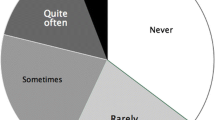Abstract
The study was designed to determine whether behavioral effects of amphetamine, which have been used to predict dependence potential, were stable after multiple exposures to the drug and whether these different indices of dependence potential were correlated. Ten normal human volunteers participated in a series of three identical choice experiments comparing 10 mg d-amphetamine and placebo. Each experiment consisted of nine sessions. During the first four sessions of each experiment, subjects alternately received amphetamine or placebo. During the next five sessions of each experiment, they were given a choice between amphetamine and placebo. Subjective effects were assessed using the Profile of Mood States (POMS) before drug was taken and 1, 3, and 6 h later. Liking scores were obtained after each session, as well as after each experiment. Subjects chose amphetamine an average of 3.9, 3.0, and 3.4 times out of five in the three experiments, in that order. Compared to placebo, amphetamine produced changes in mood as measured by the POMS including increased anxiety, vigor, friendliness, elation, arousal, and positive mood, and decreased fatigue. Liking scores for amphetamine were consistently higher than for placebo. Mood changes and liking scores produced by amphetamine were similar across all three experiments and across subjects. These results indicate that neither tolerance or increased sensitivity develops to the reinforcing properties of 10 mg d-amphetamine. The results are also discussed in terms of methods for predicting the dependence potential of psychotropic drugs and understanding the role of environmental context as a modulator of a drug's reinforcing effects.
Similar content being viewed by others
References
deWit H, Johanson CE, Uhlenhuth EH, McCracken S (1983) The effects of two non-pharmacological variables on drug preference in humans. In: Harris L (ed) Problems of drug dependence 1982. Nat Inst Drug Abuse Res Monogr Ser 43, pp 251–257
Fischman MW, Schuster CR (1977) Long-term behavioral changes in the rhesus monkey after multiple daily injections of d-methylamphetamine. J Pharmacol Exp Ther 201:593–605
Fischman MW, Schuster CR, Resnekoy L, Shick JFE, Krasnegor NA, Fennel W, Freedman DX (1976) Cardiovascular and subjective effects of intravenous cocaine administration in humans. Arch Gen Psychiatry 33:983–989
Griffiths RR, Bigelow GE, Liebson IA (1974) Suppression of ethanol self-administration by contingent time-out from social interactions in alcoholics. Behav Res Ther 12:327–334
Griffiths RR, Bigelow GE, Henningfield JE (1980) Similarities in animal and human drug taking behavior. In: Mello NK (ed) Advances in substance abuse: Behavioral and biological research, vol 1. JAI, Greenwich CT, pp 1–90
Griffiths RR, Bigelow G, Liebson I (1976) Human sedative selfadministration: Effects of interinjection interval and dose. J Pharmacol Exp Ther 197:488–494
Jasinski DR (1973) Assessment of the dependence liability of opiates and sedative-hypnotics. In: Goldberg L, Hoffmeister F (eds) Psychic dependence: Bayer symposium IV. Springer, Berlin Heidelberg New York, pp 160–170
Johanson CE (1975) Several pharmacological and environmental variables affecting drug preference in rhesus monkeys. Pharmacol Rev 27:343–355
Johanson CE, Balster RL (1978) A summary of the results of a self-administration study using substitution procedures in primates. Bull Nare 30:43–54
Johanson CE, Uhlenhuth EH (1980a) Drug preference and mood in humans: d-Amphetamine. Psychopharmacology 71:275–280
Johanson CE, Uhlenhuth EH (1980b) Drug preference and mood in humans: Diazepam. Psychopharmacology 71:269–274
Johanson CE, Uhlenhuth EH (1981) Drug preference and mood in humans: Repeated assessment of d-amphetamine. Pharmacol Biochem Behav 14:159–163
Johanson CE, Uhlenhuth EH (1982) Drug preference in humans. Fed Proc 41:228–233
Lasagna L, von Felsinger JM, Beecher HK (1955) Drug-induced mood changes in man. I. Observations on healthy subjects, chronically ill patients, and ‘post-addicts’. JAMA 157:1006–1020
Martin WR (1973) Assessment of the abuse potentiality of amphetamines and LSD-like hallucinogens in man and its relationship to basic animal assessment programs. In: Goldberg L, Hoffmeister F (eds) Psychic dependence: Bayer symposium IV. Springer, Berlin Heidelberg New York, pp 146–155
Martin WR, Fraser HF (1961) A comparative study of physiological and subjective effects of heroin and morphine administered intravenously in postaddicts. J Pharmacol Exp Ther 133:388–399
Martin WR, Sloan JW, Sapira JD, Jasinski DR (1971) Physiologic, subjective and behavioral effects of amphetamine, methamphetamine, ephedrine phenmetrazin, and methylphenidate in man. Clin Pharmacol Ther 12:245–258
Mello NK, Mendelson JH (1965) Operant drinking of alcohol on a ratecontingent ratio schedule of reinforcement. J Psychiatr Res 5:145–152
Mello NK, Mendelson JH, Kuehnle JC, Sellers MS (1980) Operant analysis of human heroin self-administration and the effects of naltrexone. J Pharmacol Exp Ther 216:45–54
Mendelson JH, Kuehnle JC, Greenberg I, Mello NK (1976) Operant acquisition of marihuana in man. J Pharmacol Exp Ther 198:42–53
Meyer RE, Mirin SM (eds) (1979) The heroin stimulus: Implications for a theory of addiction. Plenum, New York
McNair DM, Lorr M, Droppleman LF (1971) Profile of mood states. Educational and Industrial Testing Seryice, San Diego
Post R, Kopanda RT, Black KE (1976) Progressive effects of cocaine ou behavior and central amine metabolism in rhesus monkeys: Relationship to kindling and psychosis. Biol Psychiatry 11:403–417
Schuster CR, Dockens WS, Woods JH (1966) Behavioral variables affecting the development of amphetamine tolerance. Psychopharmacologia 9:170–182
Schuster CR, Smith BB, Jaffe JH (1971) Drug abuse in heroin users: An experimental study of self-administration of methadone, codeine and pentazocine. Arch Gen Psychiatry 24:359–362
Segal DA, Mandell AJ (1974) Long-term administration of d-amphetamine: Progressive augmentation of motor activity and stereotypy. Pharmacol Biochem Behav 2:249–255
Thompson T, Unna K (eds) (1977) Predicting dependence liability of stimulant and depressant drugs. University Park Press, Baltimore
Woolverton WL, Kandel D, Schuster CR (1978) Tolerance and cross-tolerance to cocaine and d-amphetamine. J Pharmacol Exp Ther 205:525–535
Author information
Authors and Affiliations
Rights and permissions
About this article
Cite this article
Johanson, C.E., Kilgore, K. & Uhlenhuth, E.H. Assessment of dependence potential of drugs in humans using multiple indices. Psychopharmacology 81, 144–149 (1983). https://doi.org/10.1007/BF00429009
Received:
Accepted:
Issue Date:
DOI: https://doi.org/10.1007/BF00429009




